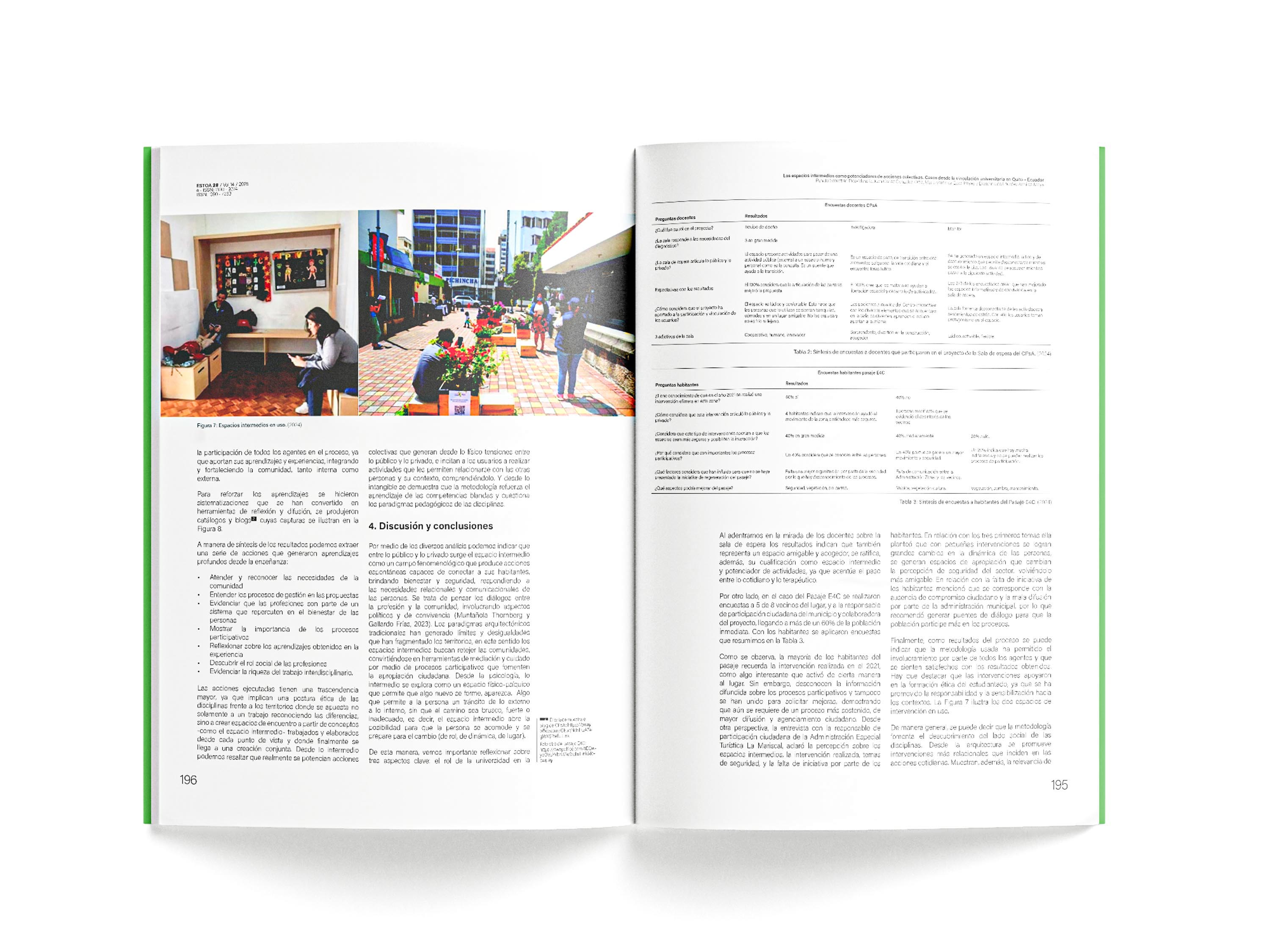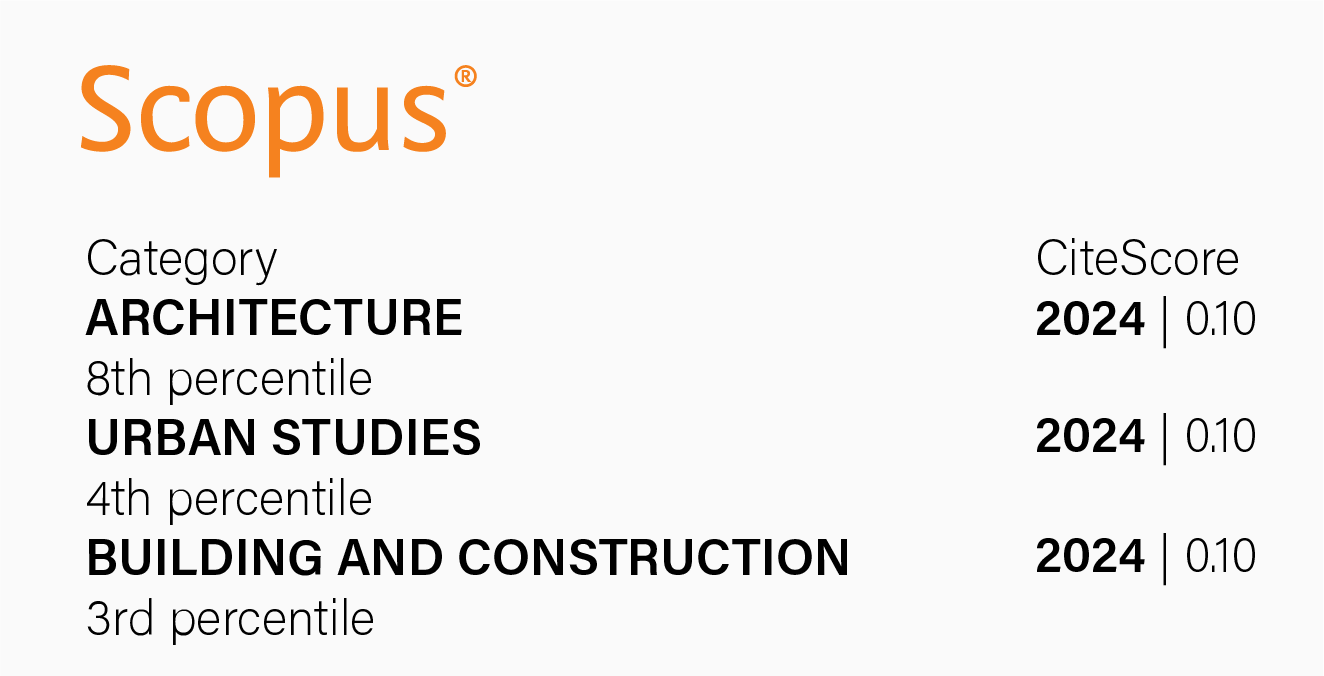Intermediate spaces as enhancers of collective actions. Cases from the university connection in Quito – Ecuador
DOI:
https://doi.org/10.18537/est.v014.n028.a13Keywords:
in between spaces, responsibility, commitment, education, appropriationAbstract
The intermediate spaces are understood as dynamic devices that promote actions between the public and the private. The Research Group on Imaginaries and Transformation of Living Landscapes (GI ITPV) at the Pontifical Catholic University of Ecuador has conducted multiple studies on the public and private aspects of architecture, observing that in the city of Quito there is little appropriation of the territories. Based on these findings, it is proposed to carry out activations to enhance the intermediate spaces and thus provoke greater appropriation. In this sense, two proposals have been developed that have allowed us to understand these dynamics and raise awareness among future architectural professionals about their actions, also covering the social role of the university today.
Downloads
References
Barrientos-Díaz, M. P., y Nieto-Fernández, E. J. (2021). Aprender a convivir con los demás a través del diseño. Comunidades de prácticas y conocimientos menores. Arquitecturas del Sur, 39(60), 62–77. https://doi.org/10.22320/07196466.2021.39.060.04
Chinchilla, I. (2020). La ciudad de los cuidados. Salud, economía y medio ambiente. Los libros de la Catarata.
Colmenares E., A. (2012). Investigación-acción participativa: una metodología integradora del conocimiento y la acción. Revista Latinoamericana de Educación, 3(1), 102–115. https://doi.org/10.18175/vys3.1.2012.07
Easterling, K. (2021). Diseño del medio: Saber cómo trabajar el mundo. Bartlebooth.
Gehl, J. (2006). La humanización del espacio urbano. La vida social entre los edificios. Reverté.
González Ortiz, J. C., y Ríos Mantilla, R. S. (2021, julio). Architecture with the Community, development, and community sustainability opportunities from architecture learning. Volume XII - Fourteenth International Conference, Virtual. https://www.istr.org/page/WP_2021
González Ortiz, J. C., Yépez Reyes, V., y García, E. (2019). Vinculación con la colectividad: una propuesta de gestión. Killkana Social, 3(2), 29–36. https://doi.org/10.26871/killkana_social.v3i2.464
González-Ortiz, J. C., Ríos, R., y Armijos, E. (2018). Estrategias de diseño del espacio doméstico para fortalecer la apropiación de sus usuarios. Eídos UTE, 1–19.
Hernández-Aja, A., y González-García, I. (2023). En defensa del planeamiento como proyecto colectivo frente a los retos actuales de transición eco-social. Ciudad y Territorio Estudios Territoriales, 55(217), 635–648. https://doi.org/10.37230/CyTET.2023.217.4
Martínez, A. M., Torres de Haro, M., y Lozano Díaz, A. (2020). El territorio como contexto educativo desde el que luchar por la igualdad y la cohesión social. En P. Aramburuzabala, C. Ballesteros, J. García, y P. Lázaro (Eds.), El Papel del Aprendizaje-Servicio en la Construcción de una Ciudadanía Global (pp. 877–882). Universidad Nacional de Educación a Distancia.
Merizalde Zapata, N. V., y Lara Calderón, M. L. (2023). Proyectar la vivienda no solo desde la individualidad, sino desde la comunidad. Reflexiones sobre la vivienda en Quito. Estoa. Revista de la Facultad de Arquitectura y Urbanismo de la Universidad de Cuenca, 12(24), 136–148. https://doi.org/10.18537/est.v012.n024.a11
Montaner, J. M., y Muxí, Z. (2020). Política y Arquitectura. Por un urbanismo de lo común y ecofeminista. Editorial Gustavo Gili.
Muntañola Thornberg, J., y Gallardo Frías, L. (2023). Diálogos entre arquitectura y comunidad sobre los lugares de convivencia. Revista de Arquitectura, 28(44), 1–11. https://doi.org/10.5354/0719-5427.2023.71107
Puig Rovira, J. M. (2021). Pedagogía de la Acción Común. GRAÓ, de IRIF, S.L.
Ríos, R., González-Ortiz, J. C., Armijos, E., Borja, K., y Montaño, M. D. (2016). Estrategias para el arquitecto intérprete: El Consultorio en el Laboratorio de los Paisajes Vivos. Arquitecturas del Sur, 34(49), 22–31. http://revistas.ubiobio.cl/index.php/AS/article/view/2264/2138
Rocha, L. (2018). Arquitectura crítica. Proyectos con espíritu inconformista. Turner Pub.
Rocha, L. (2022). Comunidad en obra. La construcción de los espacios sociales. Turner Publicaciones SL.
Secchi, B. (2015). La ciudad de los ricos y la ciudad de los pobres. Los libros de la catarata.
Seguí, J. (2018). Apuntes inéditos. S/E.
Stengers, I. (2019). Otra ciencia es posible. Manifiesto por una desaceleración de las ciencias. Ned Ediciones.
Vallaeys, F. (2020). Hacia una política pública latinoamericana de Responsabilidad Social Universitaria: Innovación social, calidad y pertinencia de la educación superior. CAF, URSULA.
Velázquez, R., y Zino, L. (2016). Transiciones. Una arquitectura de espacios intermedios: la obra de Basil y Viola en la ciudad de Minas. Revista de la Facultad de Arquitectura, 14, 44–53. https://www.colibri.udelar.edu.uy/jspui/handle/20.500.12008/18365
Winnicott, D. (1972). Realidad y juego. Gedisa.

Published
How to Cite
Issue
Section
License
Copyright (c) 2024 Estoa. Journal of the Faculty of Architecture and Urbanism

This work is licensed under a Creative Commons Attribution-NonCommercial-ShareAlike 4.0 International License.
The Journal declines any responsibility for possible conflicts derived from the authorship of the works that are published in it.
The University of Cuenca in Ecuador conserves the patrimonial rights (copyright) of the published works and will favor the reuse of the same ones, these can be: copy, use, diffuse, transmit and expose publicly.
Unless otherwise indicated, all contents of the electronic edition are distributed under a Creative Commons Attribution-NonCommercial-ShareAlike 4.0 International License.



